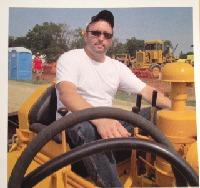- Posts: 23
- Thank you received: 0

ACMOC Membership Benefits
- FREE quarterly magazine filled with content about antique Caterpillar machines
- FREE classified listings
- ACMOC store discounts and specials
- Full Bulletin Board Access
- Marketplace (For Sale/Wanted)
- Technical Library
- Post attachments
$44 /year ELECTRONIC
$60 /year USA
$77 /year International
D 2 Steering Clutches
Thanks,
Dogger
Please Log in or Create an account to join the conversation.
Please Log in or Create an account to join the conversation.
- the Farmer3
-

- Offline
- Premium Boarder
- User
- Posts: 115
- Thank you received: 0
Please Log in or Create an account to join the conversation.
Please Log in or Create an account to join the conversation.
Tom
Please Log in or Create an account to join the conversation.
When I mentioned the difference in the bearing housings I was referring to the two styles as illustrated in my parts book (not a current one, an older reproduction). The oil and grease applications listed the same 2B9338 bearing for each, but the housings differ somewhat. The oil type housing was a 4B3540 which has only an oil slinger and snap ring retainer around the bearing. The grease type housing was a 1H8950 that is sealed with two plugs at the rear and has a provision for a 1H8128 seal at the front. I know that modifications to existing parts like adding plugs where they previously weren't used changes the part number, but there was also what looks like a machined grease channel around the bearing bore. Going by those observations they looked like different setups to me. The oil cups and grease hoses appear to attach similarly.
I never contacted Cat to see if there were revised parts that substituted these, thus throwing all these numbers out the window. If there is a new bearing that simplifies the changeover it would be worth checking into.
Being that I was using the old oil setup, I got the insides of the steering clutch housings as clean as I could to try to avoid the debris problem. The trouble was when I finished there was so much bare metal showing, and the primer and paint was right over there, and......well, you know what happened next.
Please Log in or Create an account to join the conversation.
I might have to check into that some day, I am going to have to go through this myself eventually.
Parts look good, Toby! if nothing else, painting them will make the gook sloough off much easier.Save the next guy who rebuilds it (in 2076) a lot of trouble!
alan627b
Please Log in or Create an account to join the conversation.
A question for you, how did you press on the inner and outer drums? Did you have a track press or did you just torque the bolts down?
Kevin
D2 5U13247 Direct electric start, #44hyd, 2S blade, Hyster D2N
Please Log in or Create an account to join the conversation.
Now, with that being said, I don't have any pressing tools, and I can't justify the cost for the extremely limited use they would get. Old Cats are a hobby for me, and sometimes I make due with what I have to keep things from becoming cost prohibitive. I'll probably catch some flak for this, but here goes. My book specifies pressing the drums and clutches to 15 tons pressure, although I've heard from other sources even down to 10 tons is adequate. Well, I have an old machinists manual with different torque charts that give approximate clamp load values for given sizes and grades of bolts, at incremental torque readings. If I remember correctly (which is hit or miss on a good day) the bolts in question were 3/4 x 16 threadpitch:confused: and assuming they were grade 8, around 260ft.lb. would apply in the ballpark of 19,000 pounds of pressure to the immediate area. If the bolt didn't line up with the lock after torqing I would advance it just enough to bend the lock squarely on one of the flat sides.
I can't say how accurate the chart is or even how close this would get to the press method, but that's what I've done on all my D2's I've had apart. I first tried this on my 5J about five years ago and nothing's loosened up yet. It definitely helps if all your threads and splines are absolutely clean and in excellent condition. Worn components will loosen up a lot easier than good ones.
If I were to do this job for somebody else I would have them pressed together but it doesn't bother me to work around that on my own stuff, I just keep in mind if problems arise I only have myself to blame.
Please Log in or Create an account to join the conversation.
Please Log in or Create an account to join the conversation.
ACMOC
Antique Caterpillar Machinery Owners Club
1115 Madison St NE # 1117
Salem, OR 97301
support@acmoc.org
"I became a member recently because the wealth of knowledge here is priceless."
- Chris R
"I also joined a year ago. had been on here a couple of times as a non-member and found the info very helpful so I got a one year subscription (not very expensive at all) to try it out. I really like all the resources on here so I just got a three year. I think its a very small price for what you can get out of this site."
- Jason N


